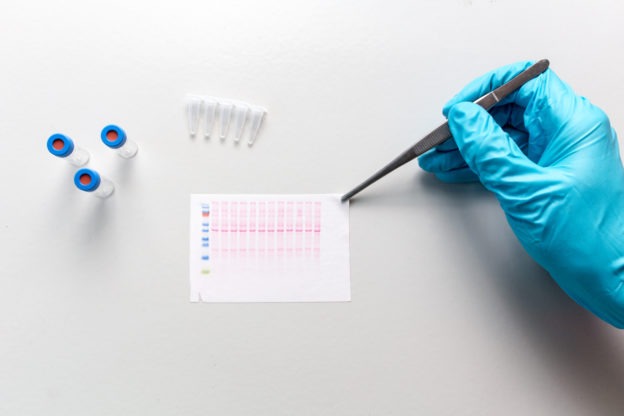Instructor
Monica E. Embers, PhD
Associate Professor in the Division of Immunology
Director of Vector-borne Disease Research
Tulane National Primate Research Center
Description
This module presents the most commonly used tests to diagnose Lyme disease, describes their deficiencies, and provides clinicians with important findings regarding the variability in immune responses among infected individuals. How to interpret the two-tier test, especially the western blot, is discussed in detail and in conjunction with the research findings on immune response differences. Finally, the needs and challenges for new diagnostic modalities are considered.
Learning objective
- Make a fast and accurate diagnosis of Lyme disease

Learners may receive credit for this course through either the Accreditation Council for Continuing Medical Education (ACCME) or the American Academy of Family Physicians (AAFP).
Invisible International is accredited by the Accreditation Council for Continuing Medical Education (ACCME) to provide continuing medical education for physicians.
Invisible International designates this enduring material activity for a maximum of 0.5 AMA PRA Category 1 Credit™. Physicians should only claim credit commensurate with the extent of their participation in the activity.
ACCME Activity Release Date: 8/1/2023; Expiration 7/31/2024.
Additionally, this session, Diagnostic challenges in Lyme disease, is approved for 0.5 enduring AAFP Prescribed credits.
AAFP Prescribed credit is accepted by the American Medical Association as equivalent to AMA PRA Category 1 credit(s)™ toward the AMA Physician’s Recognition Award. When applying for the AMA PRA, Prescribed credit earned must be reported as Prescribed, not as Category 1.
The AAFP has reviewed One Health Medical Education for a Changing Climate and deemed it acceptable for AAFP credit. Term of approval is from 01/02/2024 to 01/01/2025. Physicians should claim only the credit commensurate with the extent of their participation in the activity.
Disclosure to Learners
CME content presented to learners is free of commercial bias. No product, service, or therapeutic option will be over‐represented when comparing competing products, services, and therapeutic options. When appropriate, generic names or trade names from several companies will be used. Unless otherwise noted, none of those who controlled content had any financial relationships with an ineligible company. When a planner or faculty member has disclosed a relevant relationship, that relationship has been mitigated by review of all planning and presentation content.
Planner: Elizabeth Lee-Lewandrowski, PhD, MPH, is a consultant for Quidel Ortho Diagnostic
Faculty: Monica Embers, PhD, is a stock owner of LymeSeq
References
Mead P, Petersen J, Hinckley A. Updated CDC Recommendation for Serologic Diagnosis of Lyme Disease. MMWR Morb Mortal Wkly Rep 2019;68:703. https://www.cdc.gov/mmwr/volumes/68/wr/mm6832a4.htm?s_cid=mm6832a4_w
https://ndc.services.cdc.gov/case-definitions/lyme-disease-2022/
Philipp, M. T., A. R. Marques, P. T. Fawcett, L. G. Dally and D. S. Martin (2003). “C6 test as an indicator of therapy outcome for patients with localized or disseminated lyme borreliosis.” Journal of Clinical Microbiology 41(11): 4955-4960.
Philipp, M. T., G. P. Wormser, A. R. Marques, S. Bittker, D. S. Martin, J. Nowakowski and L. G. Dally (2005). “A decline in C6 antibody titer occurs in successfully treated patients with culture-confirmed early localized or early disseminated Lyme Borreliosis.” Clin Diagn Lab Immunol 12(9): 1069-1074.
Branda JA, Linskey K, Kim YA, Steere AC, Ferraro MJ. Two-tiered antibody testing for Lyme disease with use of 2 enzyme immunoassays, a whole-cell sonicate enzyme immunoassay followed by a VlsE C6 peptide enzyme immunoassay. Clin Infect Dis. 2011 Sep;53(6):541-7. doi: 10.1093/cid/cir464. PMID: 21865190.
Binnicker MJ, Jespersen DJ, Harring JA, Rollins LO, Bryant SC, Beito EM. Evaluation of two commercial systems for automated processing, reading, and interpretation of Lyme borreliosis Western blots. J Clin Microbiol. 2008 Jul;46(7):2216-21. doi: 10.1128/JCM.00200-08. Epub 2008 May 7. PMID: 18463211; PMCID: PMC2446909.
Heikkilä T, Seppälä I, Saxen H, Panelius J, Yrjänäinen H, Lahdenne P. Species-specific serodiagnosis of Lyme arthritis and neuroborreliosis due to Borrelia burgdorferi sensu stricto, B. afzelii, and B. garinii by using decorin binding protein A. J Clin Microbiol. 2002 Feb;40(2):453-60. doi: 10.1128/JCM.40.02.453-460.2002. PMID: 11825956; PMCID: PMC153353.
Craft JE, Fischer DK, Shimamoto GT, Steere AC. Antigens of Borrelia burgdorferi recognized during Lyme disease. Appearance of a new immunoglobulin M response and expansion of the immunoglobulin G response late in the illness. J Clin Invest. 1986 Oct;78(4):934-9. doi: 10.1172/JCI112683. PMID: 3531237; PMCID: PMC423723.
Craft JE, Grodzicki RL, Shrestha M, Fischer DK, García-Blanco M, Steere AC. The antibody response in Lyme disease. Yale J Biol Med. 1984 Jul-Aug;57(4):561-5. PMID: 6393607; PMCID: PMC2590019.
Dressler F, Whalen JA, Reinhardt BN, Steere AC. Western blotting in the serodiagnosis of Lyme disease. J Infect Dis. 1993 Feb;167(2):392-400. doi: 10.1093/infdis/167.2.392. PMID: 8380611.
Aguero-Rosenfeld ME, Wang G, Schwartz I, Wormser GP. Diagnosis of lyme borreliosis. Clin Microbiol Rev. 2005 Jul;18(3):484-509. doi: 10.1128/CMR.18.3.484-509.2005. PMID: 16020686; PMCID: PMC1195970.
Embers ME, Hasenkampf NR, Jacobs MB, Philipp MT. Dynamic longitudinal antibody responses during Borrelia burgdorferi infection and antibiotic treatment of rhesus macaques. Clin Vaccine Immunol. 2012 Aug;19(8):1218-26. doi: 10.1128/CVI.00228-12. Epub 2012 Jun 20. PMID: 22718128; PMCID: PMC3416093.
Aucott, J. N., L. A. Crowder and K. B. Kortte (2013). “Development of a foundation for a case definition of post-treatment Lyme disease syndrome.” International Journal of Infectious Diseases 17(6): e443-e449.
Blum, L. K., J. Z. Adamska, D. S. Martin, A. W. Rebman, S. E. Elliott, R. R. L. Cao, M. E. Embers, J. N. Aucott, M. J. Soloski and W. H. Robinson (2018). “Robust B Cell Responses Predict Rapid Resolution of Lyme Disease.” Front Immunol 9: 1634.


